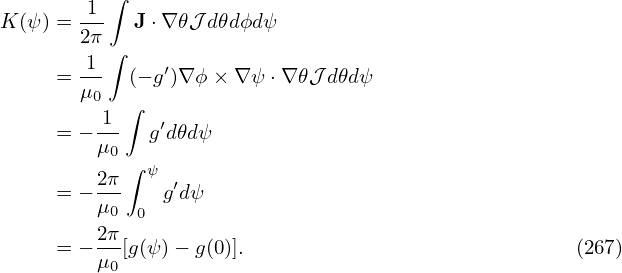
The usefulness of the contravariant form [Eq. (262] of the magnetic field lies in that it allows a simple form of B ⋅∇ operator in a coordinate system. (The operator B0 ⋅∇ is usually called magnetic differential operator.) In (ψ,𝜃,ζ) coordinate system, by using the contravariant form Eq. (262), the operator is written as
Next, consider the solution of the following magnetic differential equation:
 | (271) |
where h = h(ψ,𝜃,ζ) is some known function. Using Eq. (270), the magnetic differential equation is written as
 | (272) |
Note that the coefficients before the two partial derivatives of the above equation are all independent of 𝜃 and ζ. This indicates that different Fourier harmonics in 𝜃 and ζ are decoupled. As a result of this fact, if f is Fourier expanded as
 | (273) |
(note that, following the convention adopted in tokamak literature[10], the Fourier harmonics are chosen to be ei(m𝜃−nζ), instead of ei(m𝜃+nζ)), and the right-hand side is expanded as
 | (274) |
then Eq. (272) can be readily solved to give
![γmn
fmn = i[m-−-nq].](tokamak_equilibrium362x.png) | (275) |
The usefulness of the straight line magnetic coordinates (ψ,𝜃,ζ) lies in that, as mentioned previously, it makes the coefficients before the two partial derivatives both independent of 𝜃 and ζ, thus, allowing a simple solution to the magnetic differential equation.